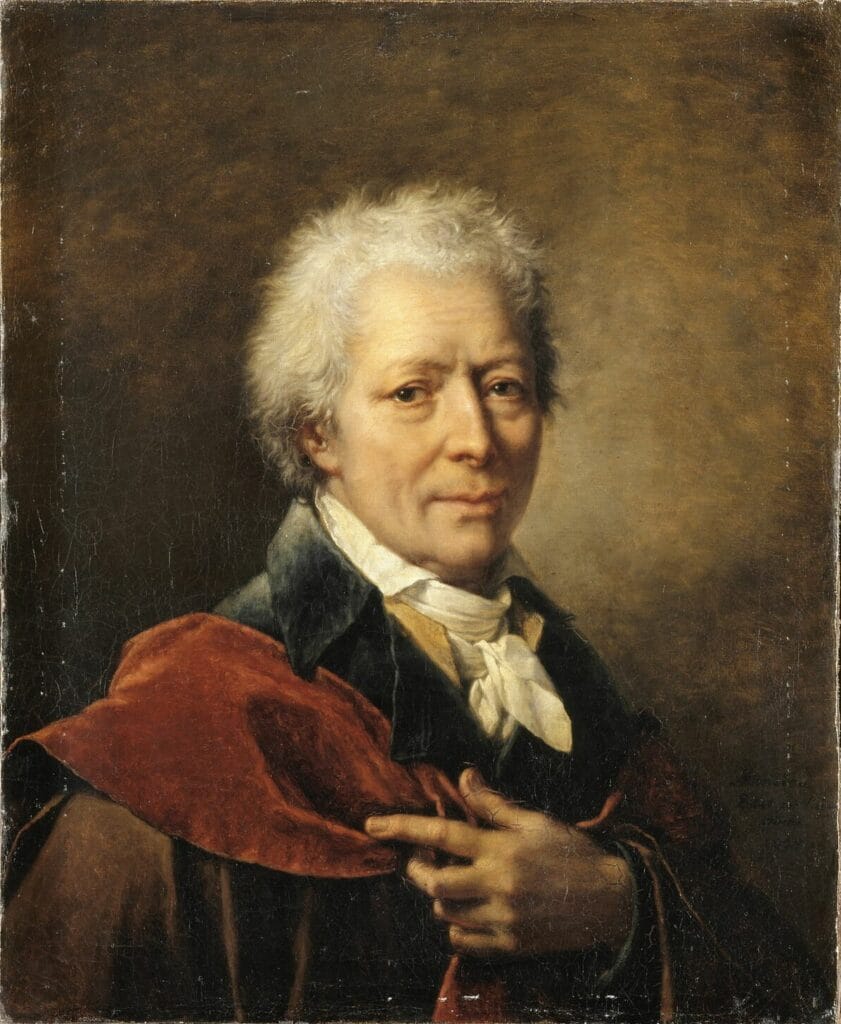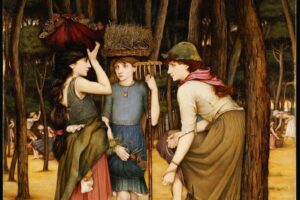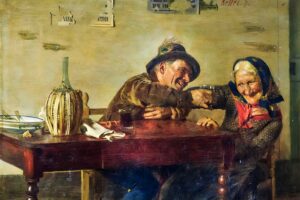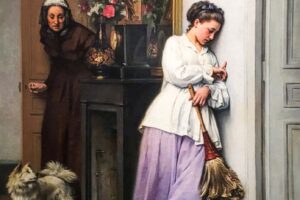The Spark of Thought and Love
The Debate of Socrates and Aspasia by Nicolas-André Monsiau takes us into a sunlit room in ancient Athens—not a battlefield of swords, but one of ideas, where minds clash and hearts quietly stir. Painted in 1801, during the age of Neoclassicism, this work invites us into a scene where philosophy, intellect, and emotion come face to face.
The Woman with Words
Seated at the right, draped in flowing white and sky-blue robes, is Aspasia, one of the most fascinating women of ancient Greece. Known as a companion to Pericles and a teacher of rhetoric, she was admired for her intelligence and grace. Here, she leans forward, hands raised in expressive motion, clearly engaged in a passionate exchange. Before her lies a table with scattered roses, a scroll, and a helmet—symbols of beauty, thought, and war. She is not silent. She is not shy. She debates.
The Philosopher Who Listens
On the left, old Socrates sits hunched forward, his staff in one hand, his gaze fixed on Aspasia. His body is calm, but his mind is alert. The great philosopher, who often asked questions rather than gave answers, seems here to be the one learning. His expression is curious, even amused, as if delighted by the spirited challenge before him. Socrates, the wise, meets Aspasia, the eloquent—and something electric passes between them.
The Youth in Armor
Between them stands a young warrior, possibly Alcibiades, watching silently. Dressed in gleaming armor and a crested helmet, he seems unsure whether to join in the conversation or simply bear witness to it. His presence bridges the world of action and the world of ideas. He represents the next generation—caught between the fire of passion and the call of thought.
A Meeting of Equals
This is more than a painting of a conversation. It is a portrait of balance—between man and woman, reason and feeling, strength and grace. Aspasia is not shown as a muse, but as a thinker. Socrates is not shown as an unchallenged sage, but as someone willing to listen. In a time when women’s voices were often left out of history, this canvas brings one vividly to life.
Eternal Dialogue
Monsiau’s painting reminds us that real wisdom isn’t loud or forceful—it listens, it learns, and it dares to question. The scene may be ancient, but its message is timeless: the most important debates don’t always happen in courts or assemblies. Sometimes, they happen between two people, seated across a table, under the quiet light of understanding.
About Artist

Nicolas-André Monsiau (1754–1837) was a prominent French history painter aligned with the Neoclassical tradition. Trained at the Académie Royale de Peinture et de Sculpture in Paris under Jean-François Pierre Peyron, Monsiau’s work combines classical themes with a refined draftsmanship reminiscent of Poussin. While his early career faced challenges gaining official Salon admission, he eventually became well known for his historical and literary scenes, which conveyed narrative clarity and emotional depth.
Monsiau was among the first to depict modern history and literary scenes beyond conventional battle commemorations, bringing dramatic moments to the forefront with balanced composition and detailed characterization. His style is noted for its austerity in color, strong linear drawing, and theatrical staging, bridging late Enlightenment ideals with early Romantic sensibilities.
Notable Artworks of Nicolas-André Monsiau
- The Debate of Socrates and Aspasia (1801)
Also known as Aspasia Conversing with Socrates and Alcibiades, this painting is housed in the Pushkin Museum. Monsiau illustrates a philosophical and historical episode involving Socrates, the great Athenian philosopher, and Aspasia, a prominent intellectual woman of ancient Athens. The scene captures intellectual exchange and dramatic dialogue, highlighting his talent for narrative history painting. - The Lion of Florence (1801)
Held at the Louvre Museum, this work vividly depicts a dramatic event where a wild lion from a menagerie in Florence spares a child it had captured, blending tension and a miraculous rescue in a grand historical style. - Les Membres de la Consulta de la République Cisalpine (1808)
A monumental historical painting commissioned to commemorate Napoleon delivering a constitution to the Cisalpine Republic. It exemplifies his capacity to depict contemporary political events with classical grandeur. - Louis XVI Giving Instructions to La Pérouse (1817)
This work shows the French king instructing the explorer La Pérouse prior to his circumnavigation. It symbolizes enlightened patronage of exploration and science prior to the French Revolution, demonstrating Monsiau’s ability to weave historical narrative with portraiture. - Alexander and Diogenes (1818)
This painting combines myth and philosophical encounter, portraying Alexander the Great visiting the philosopher Diogenes. It reflects Monsiau’s classicism and interest in heroic and intellectual themes.
Monsiau’s oeuvre is marked by a synthesis of classical rigor and a vivid storytelling approach, placing him among the notable French Neoclassical painters who bridged tradition and modernity in late 18th and early 19th-century art. His works reside in major museums and continue to be studied for their historical and artistic importance.Here is a profile of Nicolas-André Monsiau with notable paintings including “The Debate of Socrates and Aspasia.



